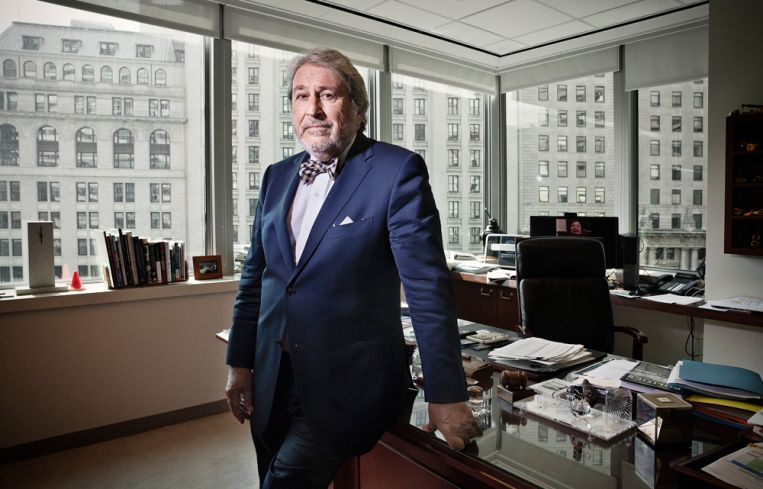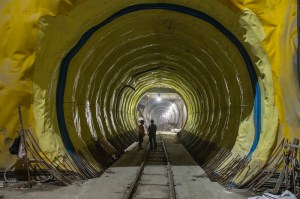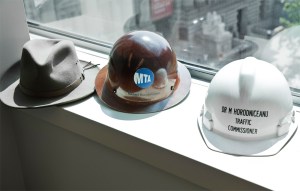Michael Horodniceanu, Head of MTA Capital Construction, Talks East Side Access and More
By Terence Cullen August 12, 2015 11:45 am
reprints
If you’re attending an early morning real estate panel all the way Downtown, a good way to wake up might not just be a cup of coffee, but to listen to Michael Horodniceanu.
The career urban planner lights up members of the crowd with updates and breakdowns of the train system in New York City—bringing out one’s inner train nerd.
As the president of the Metropolitan Transportation Authority Capital Construction, Mr. Horodniceanu (pronounced: horad-nitchy-anu) has spent the last seven years responsible for projects that will eventually make the trains run on time. He oversaw construction of the 7 train station that will open at West 34th Street on Sept. 13 (see story on page 38), and is currently working on the Second Avenue Subway line as well as the long-awaited East Side Access project intended to bring the Long Island Rail Road into a new terminal that will be incorporated into Grand Central.
So it’s safe to say that Mr. Horodniceanu, 70, is constantly busy. He’s balancing future projects, like bringing the Metro North to Penn Station some day, while managing current ones such as the cavernous tunnels being bored under the East River, while facing a capital budget that’s still roughly $3 billion short, according to the MTA.
When Mr. Horodniceanu sat down with Commercial Observer two weeks ago, sporting his trademark bow tie (although he insists he’s more comfortable in a hard hat), a few weeks after speaking on two panels—one at Stroock & Stroock & Lavan on the topic of the Far West Side and another hosted by the Manhattan Chamber of Commerce about East Side rezoning—he discussed how a steady investment from the private sector could help fund transit improvements and literally speed the plows under the streets. After all, tunnels the MTA is building will eventually bring workers to developers’ buildings, he said, and the relationship between transit and real estate has to stay symbiotic.
And striking a good balance is something he’s also done with the residents and merchants affected by the drilling and scaffolding on Second Avenue, with the first leg of the project still a year away from completion.
Mr. Horodniceanu, who earned his doctorate in Transportation, Planning and Engineering from what’s now NYU Polytechnic School of Engineering, has spent 40-plus years working in urban planning. He founded a consulting firm, The Urbitran Group, sold it once to become traffic commissioner during former Mayor Ed Koch’s last four years, and then sold it again when the MTA tapped him to head capital construction. He’s shifting how and where trains drop people off in the city and is conscious of how millennials are becoming more urbanized.

CO: What’s going to be the impact of the East Side Access project?
Mr. Horodniceanu: The bottom line is that this will be a game changer for many people that are actually traveling.
The expectation is that on a daily basis, one will be able to save 40 minutes a day. If you multiply it by five, that will give you an excess of three hours a week more time. Figure out what you want to do with that [extra time].
The other part that will be very interesting is that now you’re going to be able to, as an example, come from Westchester, into Grand Central, board the Long Island Rail Road, go to Jamaica and take the Air Train to JFK. It’s something that, if you ever tried to go to JFK from Manhattan in the middle of the day, you would not be a happy person.
In addition, once you free up platform space at Penn Station, you can bring Metro North trains that now only come into Grand Central into Penn Station.
There are people that want to go there, and now today, the same way you have to go to Penn Station and track your way back to Grand Central, people go to Grand Central and have to go to the West Side.
Do you have a number for how many people East Side Access is going to impact, too?
The projection right now is 160,000 passengers. That represents about half of all the passengers carried by, or projected to be carried by, Long Island Rail Road.
How far along is the MTA in that process to connect Metro North to Penn Station?
The only way that that would happen is we first have to finish the East Side Access.
[Gov. Andrew Cuomo] committed money for four stations in the Bronx. When the Metro North trains are coming through the Bronx, they will be able to stop and pick up passengers in the Bronx, and then travel all the way to Penn Station.
Between East Side Access and the Second Avenue Subway, what are these things going to do for the East Side?
I’m going to dissect it separately because these are independent in many ways. East Side Access with the rezoning that is taking place now around Grand Central, obviously bringing the Long Island Rail Road there it is going to give you the boost, because now not only is that centrally located but you also can connect it to Long Island and whatever happens now in Midtown is going to be supported by additional mass transit.
The point I’m making is that that’s very important and that will support the additional real estate that is coming online there.
Second Avenue is a totally different thing. Second Avenue [subway] is a project that has been around for a long, long time. In fact, not long ago, there was an article that in effect—I don’t know if it accused me but pointed out—that I’m 86 yearas late. I don’t think I was even planned 86 years ago.
But Second Avenue will also be an incredible push for the East Side of Manhattan real estate. There will be, I believe, a move to increase the density along Second Avenue. We are right now close to about 80 percent done. We have another 17 months to go. I think that it’s going to be tough to complete it because we need to do a lot of testing and commissioning in the process.
Remember our subway system is just about 100 years old. We actually have to take brand-new technology and make it work with lots of old stuff. If you were at our board meeting about a week ago, you would have seen that in some areas our signal system when trains go by, we still do it by hand. It’s not even electronically done.

Has the community pushed back on the scaffolding and construction around the Second Avenue Subway project?
When we started it [in 2008], the community was not happy with us. I needed to do something [about] that, because this was a first anyway for us—we never built in such a densely populated area—I made a decision [to make] myself the face of the project. That means the message to the residents was that the buck stops with me. I believe that the program that we put in place was extremely effective to accomplish what we wanted. We wanted was something very important. It’s called trust. Government in general is not really looked upon as the most trustworthy player.
We had a gentleman who still owns a restaurant at 92nd Street. It’s called Delizia. He was my biggest nemesis. Every Sunday, he got the politicians around and they basically screamed and yelled. So I went to see him when I decided that I have to do much more. I was able to work with him and make changes to the way we’re doing the work.
And then eventually he became my ambassador. That means from the biggest detractor he now would go and say, “Trust him. He is telling you the truth and will do the right thing.” And I did that.
Could either the Hudson Yards model of leveraging development rights or tying transportation upgrades to upzoning like in Midtown East be a model for filling future capital budget gaps?
At one point our transit system gets choked and you need to expand it. So it makes a lot of sense that the real estate people ought to be much more supportive of New York City Transit and MTA in general. We’re bringing their people back and forth.
People talk about lots of stuff, but basically, I believe that the real estate community ought to in effect come up with funding. When I say come up with funding, someone is always good at giving us a one-shot deal. It’s not good. We need a dedicated source of money so you can rely on it.
You have to maintain a level source of dollars that comes in to maintain and expand our system.
That needs to be done through a kind of taxation. I was at a conference when someone was talking about there being a rent tax that the city collects south of 96th Street. Someone was proposing that should be eliminated. I’m saying don’t eliminate it; just use that to fund transit. Not just fund transit operations, that’s different. Fund capital improvements; fund the maintenance.
Are you an MTA commuter?
No. I drive a truck. In the back of my truck I have boots and hard hats and all kinds of things. I should have had a telephone booth so I can go in and be like Superman and change. But I’m not, so I close the door and normally I will go in the morning to a site and I will be dressed in jeans and a T-shirt and a hard hat. I come here and I change and sometimes I change again.
You always have such good bow ties. Where do you get those?
I get them at Paul Stuart. And I actually buy when I travel overseas.
What project do you feel proudest of?
I would say [as a consultant] that one of them was doing the modeling for Manhattan for the West Way. But, I would say to you that I must be biased to what I do today. The projects that I’m doing today are projects that are changing the way New York is going to be for the next generation.
These are thing you do not get to do normally. You have to be lucky enough to be in the right place in the right time for someone to offer you a job like this. Because I did not apply for the job I have today.
I can be relevant in a way that I would have never been relevant otherwise. I remember talking to my kids, with my son that I just talked to, he’s a civil engineer, too, and I said, “I started a firm from scratch, I had all of these things, I have a legacy [with my firm].” He said, “Forget about it. Go make a different type of legacy.” And quite frankly, what I do today is so exhilarating, and I am in an enviable position that I can be happy [that] I do something that will make a difference.
For all of Commercial Observer’s coverage in the first-ever transit issue, click here.


